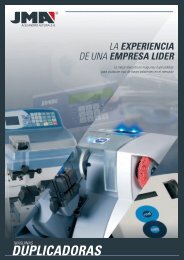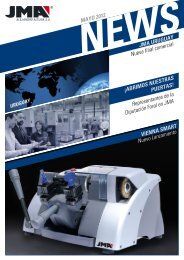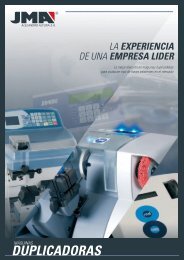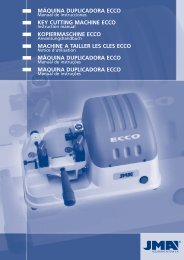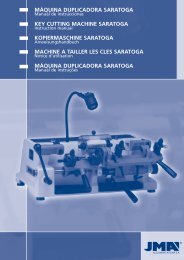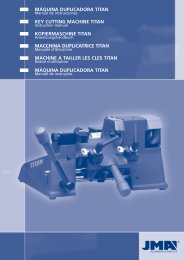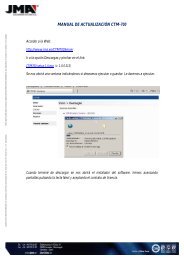MÃQUINA DUPLICADORA CAPRI Manual de ... - JMA Polska.
MÃQUINA DUPLICADORA CAPRI Manual de ... - JMA Polska.
MÃQUINA DUPLICADORA CAPRI Manual de ... - JMA Polska.
- No tags were found...
You also want an ePaper? Increase the reach of your titles
YUMPU automatically turns print PDFs into web optimized ePapers that Google loves.
- ANGLE CUT. Some keys have angle cut dimples, for which it is necessary torotate the clamp.• Carry out the vertical adjustment of the tracer point.• Activate the systems which simplify the cutting work:TRACER POINT: Activate or <strong>de</strong>activate the tracer point spring mechanism,<strong>de</strong>pending on the type of key being cut.SLIDE: Based on the mo<strong>de</strong>l of key, it may be a good i<strong>de</strong>a to activate the sli<strong>de</strong>spring mechanism, or block the sli<strong>de</strong> in the “X” direction.SUPPORT: Depending on the type of key, it may be a good i<strong>de</strong>a to use the supportlever for tubular keys.• Start rotating the cutter, having first selected one of the two speeds available.• Proceed to cut the key. If it is a dimple key, use the help of the cutting forcecontrol system.3.2.5 ME-3.P and ME-4.P keys• Use cutter-tracer point pair: F-11 / P-11.• Secure the key in the clamp using the AD-MM2 adaptor.- Position the adaptor on the clamp, so that it is stopped by the tip.- Insert the key into the adaptor.- As you secure the adaptor in the clamp, the key is secured in the adaptor.• It is necessary to block the tracer point (<strong>de</strong>activate the spring mechanism).• NOTE: After vertically adjusting the tracer point, you need to slightly lower thetracer point, by turning the adjustment wheel 5 points to the right. Then you have toinsert the tracer point in the channel of the bit and block the machine head. Next slightlyraise the tracer point so that it does not drag the key.• NOTE: We recommend using the sli<strong>de</strong> spring mechanism system.english3.2 CUTTING KEYS3.2.1 KA-2, KA-3 and KA-4 keys.• Different pairs of cutters and tracer points are used <strong>de</strong>pending on the key to be cut.See table.• The key is secured in the clamp when its shoul<strong>de</strong>rs stop it from being inserted anyfurther.• Depending on the mo<strong>de</strong>l of key to be cut, it is necessary to rotate the clamps basedon the angle required. See table.• It is necessary to activate the tracer point spring mechanism.• Use the cutting force control system to increase cutting precision.• NOTE: The dimples cut on the KA-3 key must always be on the lowest part of theclamp.• NOTE: The dimples cut on the KA-2 key must always be on the highest part of theclamp.See Fig. 53.2.2 KE-1 key.• Use cutter-tracer point pair: F-1 / P-1.• The key is secured in the clamp when its shoul<strong>de</strong>rs stop it from being inserted anyfurther, but in this case it is inserted from the back.• It is necessary to position the clamps at an angle of 5º.• It is necessary to activate the tracer point spring mechanism.• Use the cutting force control system to increase cutting precision.• NOTE: The dimples cut on the KE-1 key must always be on the highest part of theclamp.• NOTE: You have to use the relevant adaptor to cut the lateral dimples.See Fig. 63.2.3 SEA-1 key.• Use cutter-tracer point pair: F-3 / P-3.• The key is secured in the clamp when its shoul<strong>de</strong>rs stop it from being inserted anyfurther.• It is necessary to block the tracer point (<strong>de</strong>activate the spring mechanism).• NOTE: After vertically adjusting the tracer point, you need to slightly lower thetracer point, by turning the adjustment wheel 5 points to the right. Then you have toinsert the tracer point in the channel of the bit and block the machine head. Next slightlyraise the tracer point so that it does not drag the key.• NOTE: Enter through the middle of the channels without touching the si<strong>de</strong>s, and onthe second pass enter from the right si<strong>de</strong> and exit from the left, without exercising anypressure (just gently supporting the tracer point).• NOTE: To cut the lateral dimples, use the cutter-tracer point combination: F-1 /P-1. Insert until shoul<strong>de</strong>rs stop the key from going in any further. Activate the tracerpoint spring mechanism and use the cutting force control system.See Fig. 73.2.4 OP-WH.P and OP-WY.P keys• Use cutter-tracer point pair: F-11 / P-11.• The key is secured in the clamp when its tip stops it from being inserted any further.• It is necessary to block the tracer point (<strong>de</strong>activate the spring mechanism).• NOTE: After vertically adjusting the tracer point, you need to slightly lower thetracer point, by turning the adjustment wheel 5 points to the right. Then you have toinsert the tracer point in the channel of the bit and block the machine head. Next slightlyraise the tracer point so that it does not drag the key.• NOTE: We recommend using the sli<strong>de</strong> spring mechanism system.• NOTE: We recommend you do a roughing pass and then another finishing passfollowing the whole profile of the pattern of the key. Machine in a downward direction(from the tip of the key to the head).See Fig. 93.2.6 TUBULAR KEYS• Use cutter-tracer point pair: F-8 / P-8.• Secure the key in the clamp “V”.• It is necessary to activate the tracer point spring mechanism.• The cutting operation is more comfortable if you rest the hand activating the sli<strong>de</strong>activation lever on the support lever for tubular keys.See Fig. 103.2.7 FIC-2 and FIC-3 keys• Use cutter-tracer point pair: F-11 / P-11.• Secure the key in the clamp, resting it against the bottom and pushing it towardsthe front face of the clamp.• It is necessary to block the tracer point (<strong>de</strong>activate the spring mechanism).• Block the machine head at a height at which the cutter passes over the clamp butwithout brushing against it.• Cut the two top si<strong>de</strong>s.• Turn the keys taking care to remove any burrs to ensure correct positioning andclamping of the key, and cut the other two si<strong>de</strong>s of the key.See Fig. 113.2.8 WIN-1D, WIN-2D, WIN-3D and WIN-4D keys.• Use cutter-tracer point pair: F-15 / P-15.• Secure two key blanks in the clamp, and use them to vertically adjust the tracerpoint.• Clamp the original key with the teeth facing upwards (as shown in the drawing).• It is necessary to block the tracer point (<strong>de</strong>activate the spring mechanism).• Insert the tracer point precisely in one of the dimples, and block the machine headat that height.• Start cutting.See Fig. 123.2.9 JIS-4.P key• Use cutter-tracer point pair: F-11 / P-11.• Secure the key in the clamp using the AD-MJ adaptor.-Position the adaptor on the clamp, so that it is stopped by the tip.-Insert the key into the adaptor, until its shoul<strong>de</strong>rs are stopped by the plate thatrotates. In this position, clamp the key in the adaptor.• It is necessary to block the tracer point (<strong>de</strong>activate the spring mechanism).See Fig. 133.2.10 FO-6.P key• Use cutter-tracer point pair: F-22 / P-22.• Secure the key in the clamp, using the relevant adaptor.- Position and secure the adaptors on the clamp.- When positioning the key, make sure that it is really flat, so that the two cutsare the same.• It is necessary to block the tracer point (<strong>de</strong>activate the spring mechanism).• Insert the tracer point if the groove of a letter. Block the machine head and raisethe tracer point slightly so that it does not knock against the adaptor.• Start cutting.See Fig. 14Reading the co<strong>de</strong> on the original key• The original key has 6 cutting positions, which are <strong>de</strong>fined by the letters: A, B, C, D, Eand F, as shown in the figure below.See Fig. 8• In each of the key’s positions, there are 4 different possible combinations (<strong>de</strong>fined bynumbers), which we are going to indicate and number:



